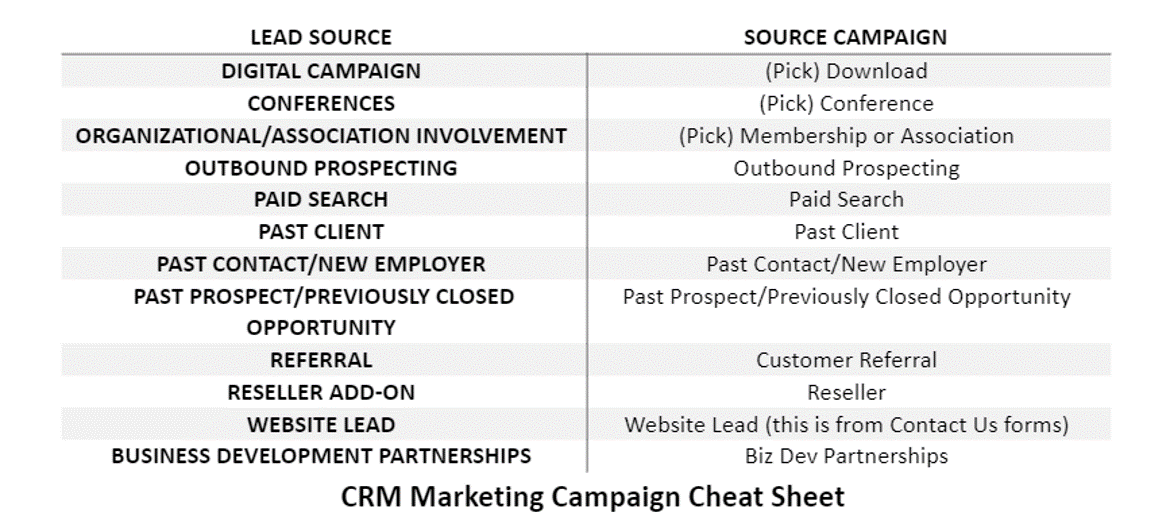You know the stereotype: in a number of organizations, Marketing is a cost center. It’s the department of pretty pictures and branding campaigns. The department where budget goes to disappear.
But marketers, we know that’s not true. We’re measuring, we’re influencing, and we’re driving in tons of opportunity. The problem isn’t that we’re a cost center; it’s that we’re not very good at telling our impact story.
The good news is we can beat the perception of Marketing as a cost center by better using our CRM systems—all it takes is a little strategic thinking and some calculations of the data you already have available to you inside the CRM system of your choice.
Here’s how to use your CRM system to prove your worth as a marketer:
Campaigns in CRM versus Campaigns in Marketing
While the purpose is essentially the same, campaign can have a different meaning in the context of marketing than what you might find in the context of your CRM. In marketing, a campaign is a series of activities organized to work toward a particular goal, like sales. In the context of your CRM, a campaign is a record that gives you a place to keep track of activities, costs, responses, and potential ROI of the campaign itself.
Keep in mind there may be times when the standard definition of “campaign” in the marketing context won’t match what you’re ultimately trying to achieve with your CRM data—which is tracking where leads and opportunities are coming from. We’ll get to that a bit later.
With each new CRM campaign you build, you’ll want to add the following pieces of information (at a minimum):
- Name
- Actual Start/End
- Estimated Revenue
- Marketing Lists
- Campaign Activities (for tracking true cost)
- Offer
- Allocated Budget
Keep in mind these fields will help you keep track of your marketing successes in the long run. Plan on collecting this information as you create your marketing plan.
CRM Architecture
Once you’ve oriented yourself in the campaigns feature of your CRM, you can create the architecture for your success. You should be tracking two layers of data:
- Lead Source—what type of campaign is this?
- Source Campaign—from which specific campaign did this lead originate?
Think of Lead Source as your big bucket—this is where you track the success of marketing activities as a category, like Events, Trade Shows, Paid Search, or Website Lead. This layer of tracking will help you understand what types of marketing events are performing well for your company.
Think of Source Campaign as your little bucket—here’s where you’re digging in at the campaign level to determine if a specific trade show or a specific paid search campaign was worth the investment. Your measurement here is the ROI on a specific campaign. This layer of reporting is great for you to know as you plan your next marketing budget, but it probably isn’t the type of report you would take to a financials meeting.
Note: these fields may be called something different or may need to be created, depending on what CRM you’re using. They are, however, very important for tracking your success. If these fields don’t exist, be prepared to make the ask for them.
Once you select your big bucket categories, be sure to map them to the appropriate campaigns or campaign types. It helps to create a cheat sheet for your sales team to follow as they enter leads, like so:

Create Your Marketing Plan
It’s a good idea to have your marketing plan in place before you enter any campaign information into your CRM. Getting this plan together, however, will involve a dive into what’s happened historically on the sales side of your CRM. To get the numbers you’ll need to prove your worth, you need to know the following:
- What’s your Lead to Opportunity conversion rate?
- What’s your Opportunity to Closed/Won rate?
- What’s your average deal size? Per product/service?
- What worked last year (e.g., where did your sales come from)?
- What do you want to try this year, and how much do you think it will cost?
This exercise does two things—first, you can set department expectations for your leadership, yourself, and your sales team, and second, you can give yourself some baseline numbers to track your success. You might put these numbers into an Excel spreadsheet, where each “big bucket” is a table and each “little bucket” is a row, like so:

In your CRM, these numbers will be reflected in:
- Estimated Revenue
- Expected Response
- Budget ROI
This exercise is also useful for showing your sales team what success looks like from each event (how many leads and opportunities do we need for a successful campaign) and for determining if the response you need to get your target ROI on an event is even possible.
Enter in Your CRM Campaigns
Once you’ve built your budget, each row in your spreadsheet will become a campaign in your CRM, along with the appropriate numbers from above. Keep in mind you will likely want to track additional sources that are not ROI-oriented, and that’s okay.
You should consider creating campaigns that are necessary but not ROI-oriented, like Referral, even if they don’t have start/end dates or associated costs. Remember you’re trying to figure out where your successes come from, and sometimes those successes aren’t from a true marketing campaign.
Tracking and Displaying Your Success
You’ve got data—now you need reports. Think of your little buckets as what your marketing team cares about and your big buckets as what the executive team cares about and create reports accordingly. You’ll need to know what’s working at the campaign level as you build out your budget proposal, but you can report to your executive team on the overall success of events as a strategy, or memberships as a strategy, and so on.
You can also use the numbers in your spreadsheet to set annual KPIs for your Marketing Department—how many total leads were driven in by Marketing last year, based on Source Campaign? That’s your starting point for creating a goal for this year. Similarly, how many Closed as Won Opportunities came from a Source Campaign that was a marketing activity? You now know what Marketing’s contribution to the sales pipeline is.
These are numbers that transform the Marketing Department from a cost center into a ROI-tracking machine—all the while proving the worth of the activities you’re running. And bonus: it’s all information you can (and should) have available to you in your CRM system.
Want to see the calculations behind that sample budget spreadsheet? Comment below or send us an email at expert@emfluence.com, and we’ll send you a sample to get started. You can also learn more about how to better talk to your CRM admins by reading this post here.



